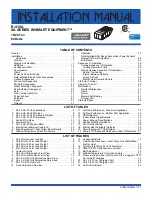
11
This will enable the heater to be serviced in its installed
location, that is, without movement or removal of the heater.
Clearances less than these (6" [152 mm] minimum), may
require removal of the heater to service either the heat
exchanger or the burner tray. In either case, the heater
must be installed in a manner that will enable the heater
to be serviced without removing any structure around the
heater.
5.2.2. Flooring
This heater can be installed on combustible flooring.
The combustible clearances listed can be reduced by
protecting the exposed combustible surfaces as shown in
Table C.
5.3. Outdoor Heater Installation
These heaters are design-certified for outdoor installation,
when equipped with the approved tops designated for
outdoor use.
A
A
WARNING:
The heater shall not be located in an area
where water sprinklers, or other devices, may cause water
to spray through the cabinet louvers and into the heater.
This could cause internal rusting or damage electrical
components, and void the warranty.
A
A
WARNING:
Do not install within 3' (914 mm) of a heat
pump or an outdoor condensing unit. Strong air intake
from this type of equipment can disturb the combustion
process and cause damage or personal injury.
PAGODA TOP
Figure 5. Heater with Outdoor Stackless Top
Heaters must not be installed under an overhang of less
than three 3' (0.9 m) from the top of the heater. Three sides
must be open in the area under the overhang. Roof water
drainage must be diverted away from the heaters installed
under overhangs with the use of gutters.
For U.S. installations, the point from where the flue
products exit the heater must be a minimum of 4' (1.2 m)
below, 4' (1.2 m) horizontally from, or 1' (0.3 m) above any
door, window or gravity inlet into any building. The top
surface of the heater shall be at least 3' (0.9 m) above any
forced air inlet, or intake ducts located within 10' (3 m)
horizontally.
For installations in Canada, pool heaters shall not be
installed with the top of the vent assembly within 10' (3 m)
below, or to either side, of any opening into the building.
Refer to the latest revisions of CAN/CSA-B149.
5.3.1. Pagoda Top Installation
1. Insert tabs into keyhole (4 places). See Figure 6,
detail A.
2. Snap tabs into keyholes so as not to pull out. See
Figure 6, detail B.
OUTDOOR TOP
(SHIPPED LOOSE WITH HEATER)
DETAIL A
DETAIL B
Figure 6. Outdoor Top Installation
For installations in Florida and Texas, that must
comply with the Florida or Texas Building Code, follow
the directions shown in Figure 9 for the installation of
hurricane tie-down brackets for all models.
5.3.2. Indoor Heater Installation
The heater is also design-certified for indoor installation
when equipped with the approved drafthood.
For Canada, indoor installation is restricted to an enclosure
that is not occupied and does not directly communicate
with an occupied area. Refer to the latest edition of CAN/
CSA-B149 for specific requirements. Locate heater as
close as is practical to a chimney or gas vent. Heater must
always be vented to the outside. See section "Vent Piping"
on page 15 for details. Minimum allowable space is
shown on the nameplate.
A
A
WARNING:
Indoor heaters require a drafthood that
must be connected to a vent pipe and properly vented to
the outside. Failure to follow this procedure can cause
fire or fatal carbon monoxide poisoning.











































